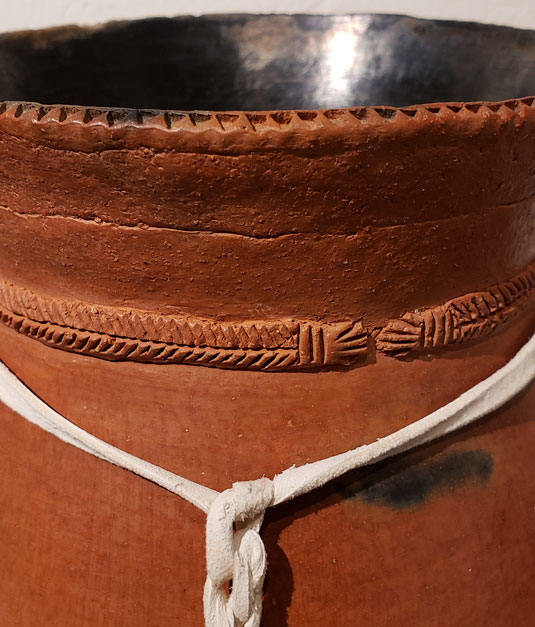Hopi-Navajo Golden Pottery Jar by Nathan Begaye [SOLD]
+ Add to my watchlist Forward to Friend
- Category: Modern
- Origin: Diné of the Navajo Nation
- Medium: clay, leather
- Size:
9-¾” height x 8-⅛” diameter - Item # C4550C SOLD
This beautiful golden-brown jar reflects the Diné culture of the mixed parentage of Nathan Begaye, whose mother was Hopi and father was Diné. Around the restricted neck is a band of incised clay of the typical style decoration on traditional Diné pottery. The potter made a slight personal variant by attaching hands on each end of the incised clay (see image below).
This clay rope or biyó, always has a traditional line break, called an atiin, “the way out.” Diné potter Rose Williams once explained the taboo against decoration and the reason for the break, as follows: “The Anasazi started to over decorate their pottery, and the wind destroyed them because of that. That’s why we are told not to decorate pottery. The coils shouldn’t come together. That opening is for life. If you make it come together, it might shorten your life.” [Rosenak 1994:35]
Below the restricted neck band, the jar was stone polished using vertical strokes on the vessel. Above the neck band, the artist left the clay in a matte state. Additionally, he left visible the line separating the two coils of clay that form the neck. The edge of the rim was finished with a pattern of indented triangular marks. The interior of the jar was stone polished and finished in black.
Added to the clay vessel is a white leather strap wrapped around the neck and braided and hanging loose. The jar does not seem to have a signature of the potter; however, it was purchased from Robert F. Nichols Gallery on Canyon Road in Santa Fe in 1993, at the time that the gallery represented the artist.
Nathan Begaye was born in Phoenix, Arizona, in 1969 to a Navajo father and a Hopi mother. He was raised by his maternal grandparents in a village of Third Mesa, and Tuba City, Arizona. His aunt was noted Hopi potter Otellie Loloma. His upbringing in the Navajo/Hopi communities was steeped in tribal traditions, and he was schooled in the lore, history, religion, symbolism, and customs of the Navajo and Hopi peoples.
Begaye's interest in pottery began early, at age 10, and he had his first public exhibition only one year later. He learned traditional techniques and pigment recipes from people in his tribal community, both Navajo and Hopi. As they were tribal secrets, he kept these to himself even when he became a teacher later in life. After receiving a SWAIA scholarship, he left home at age 14 to study ceramics at the Institute of American Indian Arts (IAIA) in Santa Fe.
Nathan Begaye (1969–2010) exhibited at Peabody Essex Museum, Salem, MA; Spencer Museum of Art, University of Kansas, Lawrence, KS; Museum of Contemporary Native Arts, Santa Fe, NM; Stedelijk Museum, Hertogenbosch, Netherlands; Mint Museum of Art, Charlotte, NC; and Museum of Fine Arts, Boston, MA.
Condition: very good condition
Provenance: this Hopi-Navajo Golden Pottery Jar by Nathan Begaye is from the collection of the family who purchased it in 1993
Recommended Reading: Changing Hands: Art Without Reservation, 1: Contemporary Native American Art from the Southwest by David Revere McFadden, and Ellen Napiura Taubman, editors, 2002.
Reference: Navajo Folk Art by Chuck & Jan Rosenak, Rio Nuevo Publishers, Tucson, 1994
Relative Links: Hopi Pueblo, Southwest Indian Pottery, Navajo Nation, Nathan Begaye, Native American Artist

- Category: Modern
- Origin: Diné of the Navajo Nation
- Medium: clay, leather
- Size:
9-¾” height x 8-⅛” diameter - Item # C4550C SOLD



